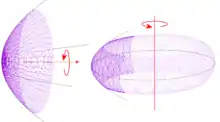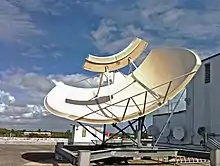Parabolic torus reflector antenna
A parabolic torus reflector antenna is a quasi-parabolic antenna, where the defining parabola is not rotated around the main transmission axis, but around an axis which stands vertically to this axis.

Form of classic parabolic dish antenna and parabolic torus reflector antenna

Simulsat antenna in Miami with casing for several LNBs
Simulsat is a trademark for such antennas designed and manufactured by Antenna Technology Communications.
Whereas parabolic satellite dishes with one low-noise block converter (LNB) are able to receive a satellite television broadcast from one communications satellite at a time, parabolic torus reflector antennas are capable of establishing views to more than 40 C and Ku band satellites simultaneously, by employing multiple LNBs.
Literature
- Alan G. P. Boswell: The parabolic torus reflector antenna. In: Marconi Review, 41, 1978, pp. 237–248.
- Biao Du, Edward K. N. Yung, Ke-Zhong Yang, Shun-Shi Zhong: Design of multibeam parabolic torus reflector antennas. In: Microwave and Optical Technology Letters, 27, 5, 2000, pp. 343–347.
- Kenneth S. Kelleher: A new wide-angle microwave reflector. In: Tele-Tech & Electronic Industries, 12, 6, 1953, pp. 98–99, 168–169.
External links
This article is issued from Wikipedia. The text is licensed under Creative Commons - Attribution - Sharealike. Additional terms may apply for the media files.